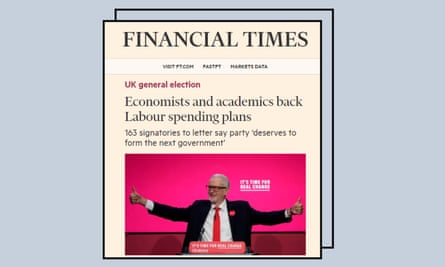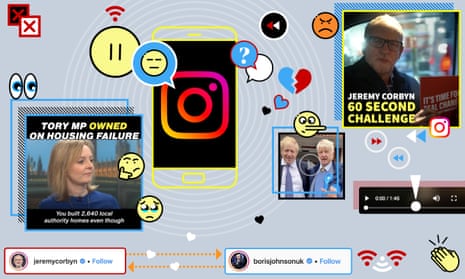Won’t somebody spare a thought for the politicians who have to sell their message in different ways to different audiences across an ever-growing number of social media platforms? No sympathy? Oh well, let’s talk about Instagram anyway.
As younger voters migrate from Facebook to its sister platform Instagram, political parties are keen to capitalise. But which of the parties and their outriders are cutting through, and what kind of messages tend to do best? We’ve taken a look at some posts from the three most successful of these accounts.
Separately, we have also taken a look at how newspaper articles (real and fake) are being used by groups online, often in flagrantly partisan ways.
@jeremycorbyn’s 60-second manifesto has Insta-appeal
Views 119,000
Likes 31,000
“BIG NEWS.” Not exactly, but this clip of Jeremy Corbyn rattling through Labour’s manifesto was the most seen of all Instagram posts by the main parties and outriders in the past week.
The clip, in which Corbyn crams as much as he can of the party’s manifesto into 60 seconds, has been watched almost 120,000 times.
This article includes content provided by Instagram. We ask for your permission before anything is loaded, as they may be using cookies and other technologies. To view this content, click 'Allow and continue'.
The Labour leader is top dog when it comes to Instagram posts, taking all five top slots in the most viewed/liked posts on the platform in the past week, a Guardian analysis shows.
In the past seven days Corbyn’s Instagram posts have attracted more than 1.9m interactions (views and likes) – four times those of Boris Johnson, whose posts attracted 506,000 interactions over the same time period.
Another popular post this week that shows Corbyn holding a plate (yes, a plate) encouraging people to vote attracted almost 46,000 likes.
@borisjohnsonuk on the campaign trail with a celebrity guest
Views 72,000
Likes 15,000
Speaking of Boris Johnson, he had a special guest appear alongside him on Instagram this week. It was … his dad, Stanley Johnson, who has been canvassing with his son after his recent stint on Celebrity Hunted (Stanley’s, not Boris’s).
It is one of four videos from Boris Johnson to make the top 20 election Instagram posts of the week.
This article includes content provided by Instagram. We ask for your permission before anything is loaded, as they may be using cookies and other technologies. To view this content, click 'Allow and continue'.
Another is a clip from last week’s Question Time debate, in which Johnson says he believes passionately in tackling poverty and seeing “equality of opportunity in this country” under a shouty banner.
@peoplesmomentum ‘owns’ Insta with cringeworthy clip
Views 41,000
Comments 3,000
If there is one thing social media loves, it’s showing videos of someone being “owned”. Momentum’s contribution to the cringe is a three-minute clip in which the BBC’s Andrew Neil interrogated the Conservative minister Liz Truss on the party’s housing record.
After grilling Truss in a manner reminiscent of Dragon’s Den, Neil asks how many of the 200,000 new starter homes her party promised five years ago have been built. Truss’s mealy-mouthed response doesn’t cut the mustard with Neil, who informs her: “It’s zero.” Ouch.
This article includes content provided by Instagram. We ask for your permission before anything is loaded, as they may be using cookies and other technologies. To view this content, click 'Allow and continue'.
Social media: showcasing a pressing issue near you
Two weeks ago we looked at how the political parties and their supporters were consistently creating successful Facebook posts by editing together short clips of UK broadcast TV and repackaging them for social media.
Something similar is happening with cuttings from newspapers. As spotted by our media editor, Jim Waterson, this week, various pro-Labour Facebook users are ecstatically circulating a link to a Financial Times article headlined: “The Labour party deserves to form the next UK government.”

In reality, this is the thrust of a joint letter to the newspaper from several economists, rather than a dramatic change of editorial direction by the FT. It’s just one example of how people can sometimes share articles without having read them, particularly if they reinforce existing views.
Using a newspaper as an authoritative source to justify a political stance is something we’ve repeatedly seen throughout this campaign.
Two weeks ago the Conservative party press-released a series of extravagant (and widely debunked) claims about the cost of Labour party policies, which were duly republished by several newspapers. The party then took the headlines from those articles, clipped them into adverts, and redistributed them on Facebook.
One example, taking a cut from the Daily Express, received between 10,000 and 15,000 impressions while costing less than £100.

To be fair, passing newspaper cuttings off as authoritative is not confined to the Tories, or to social media. The Liberal Democrats have been criticised this week for distributing fake newspapers that resemble genuine publications but are in fact propaganda, in more than a dozen seats.
The listed Instagram posts relate to posts in the week to 28 November by 14 accounts – borisjohnsonuk; brexitpartyuk; conservatives; hopenothate; jacob_rees_mogg; jeremycorbyn; jo_swinson; ledbydonkeys; libdems; nigel_farage; peoplesmomentum; pro.brexit; uklabour; voteleave.
The accounts are sorted by total interactions (the number of views plus likes in the case of videos, otherwise the number of likes). The number of views and likes were accurate as of 1pm on Thursday 28 November.
The Facebook posts are selected from a CrowdTangle list of election-related Facebook and Instagram posts, sorted by total interactions (a sum of reactions, comments and shares). The number of views, comments and shares were accurate as of 2.30pm on Thursday 28 November.
Digital dashboard team: Michael Barton, Pamela Duncan, Niamh McIntyre, David Pegg and Joseph Smith
